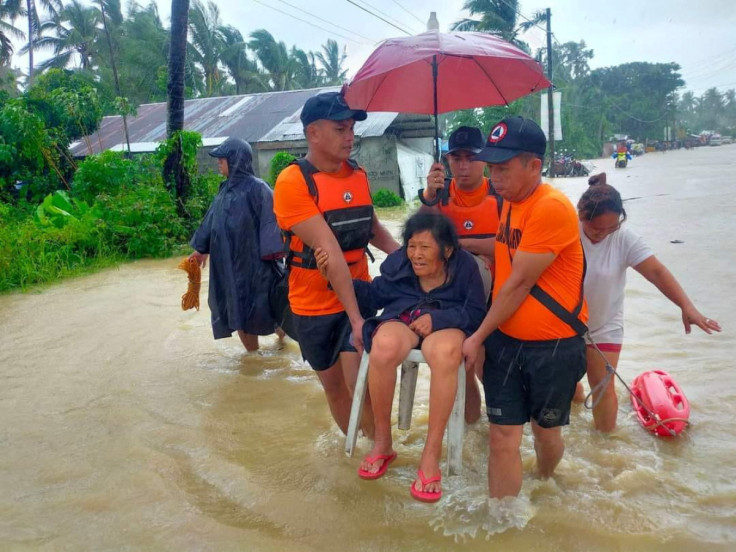
KEY POINTS
- The Philippines is first among top 10 countries with the highest disaster risk scores
- The DOST recently launched AIRCoDE that involves deep learning for flood level forecasting
- AI-powered disaster systems should have "multiple levels of checks and oversight": think tank ITIF's Daniel Castro
- Humans have a "moral responsibility" in AI system use: National Institute of Geological Sciences professor Alfredo Lagmay
In a country where natural disasters such as earthquakes are common, artificial intelligence could play a key role in strengthening disaster management systems. However, a "defense in depth" approach to AI integration should be considered to ensure that data collected for improved disaster management will serve its purpose.
The Philippines experiences many natural disasters in a year, particularly flooding due to strong typhoons and earthquakes that result in the displacement of many Filipinos. In this year's World Risk Index report, which was released in September and indicated the disaster risk of 193 countries from extreme natural events, the Philippines was on the top spot among 10 countries with the highest disaster risk rate. It scored 46.86, followed by Indonesia at 45.50 and India at 41.52.
On Saturday night, a magnitude 7.5 earthquake struck the southern region of Mindanao, triggering tsunami warnings not just within the Philippines, but also in neighboring Japan. The tsunami alerts were later canceled, but evacuations continued throughout the weekend.
Early Monday morning local time, the Philippine Institute of Volcanology and Seismology (PHIVOLC) said a 6.4 magnitude earthquake struck Surigao Del Sur in Mindanao.
#EarthquakePH #EarthquakeSurigaoDelSur#iFelt_SurigaoDelSurEarthquake
— PHIVOLCS-DOST (@phivolcs_dost) December 3, 2023
Earthquake Information No.2
Date and Time: 03 December 2023 - 12:03 AM
Magnitude = 6.4
Depth = 001 km
Location = 08.50°N, 126.95°E - 073 km N 83° E of Hinatuan (Surigao Del Sur)https://t.co/8aCBp4srDe pic.twitter.com/GZbkmpxv3a
The Philippines has been working to improve its disaster management systems, and part of its efforts include the integration of high-end technology.
Late in July, the Department of Science and Technology – Philippine Council for Industry, Energy, and Emerging Technology, Research and Development along with the Camarines Sur Polytechnic Colleges launched the AI Research Center for Community Development (AIRCoDE).
As part of the facility's launch, a research project that involved deep learning to forecast flood levels was also announced.
"This project will make a genuine difference by estimating flood levels and offering real-time notifications through websites, social media pages, and SMS in order to better prepare our community for calamities," said project leader Joseph Jessie Oñate at the time.
In mid-September, the SARwAIS project, which focused on terrestrial monitoring and maritime surveillance for data collection that can be used in disaster management and other applications, helped technical project officers of the Accelerated Earthquake Multi-hazards Mapping and Risk Assessment Program of the Philippines (ACER Program) complete their basic AI and remote sensing training series.
The Philippines has "relatively strong" internet connectivity and smartphone adoption, which are important factors to help the country in utilizing AI-enabled disaster management services, Daniel Castro, vice president of think tanks network the Information Technology and Innovation Foundation (ITIF) and director of the ITIF's Center for Data Innovation, told International Business Times.
On the other hand, Castro noted that since there were "various data sources involved" in AI training for disaster management, a stronger strategy was needed to validate data more closely.
A "human-in-the-loop" -- wherein people interfere at different stages of the AI training process to ensure that data collected and stored was accurate -- was an option, Castro said, but humans can make mistakes too.

Instead, disaster management systems with AI technology should "use a defense in depth (DiD) approach where there are multiple levels of checks and oversight to validate the integrity of the information, monitor for possible mistakes, and quickly mitigate errors," he recommended.
IT community non-profit the Center for Internet Security describes the DiD approach as an information security approach that applies a "thoughtfully layered" series of mechanisms and controls to protect data.
Alfredo Mahar Francisco A. Lagmay, professor at the National Institute of Geological Sciences at University of the Philippines, Diliman, and an academician with the National Academy of Science and Technology, told IBT that integrating AI into the country's disaster management system requires training the AI with good data.
"There is such a thing as garbage in, garbage out. AI will only produce good results if we train it on good data," he pointed out.
Lagmay noted that as AI use in climate change adaptation and disaster risk reduction efforts was becoming inevitable, the human's training of AI was critical. "Humans have a moral responsibility and accountability for AI systems," he said.
The Philippines has been pursuing AI integration in its disaster management efforts, as shown in the partnership announced in August between the Office of Civil Defense and the Department of the Interior and Local Government with Japanese startup Spectee and the Japan International Cooperation Agency (JICA).
🌏 An AI-powered alliance is on the horizon, set to revolutionize disaster management in the country. Disaster-prone PH Gov't Teams Up with Japanese Start-up Spectee and JICA 🇵🇭
— AQUACITY (@aquacity_gamefi) August 28, 2023
It's game-changing partnership, utilizing data from cameras, climate info, social media, and more.… pic.twitter.com/QSqMt2Imx7
The initiative will see Spectee piloting its AI-powered disaster management tool in the Philippines to help with providing real-time information during natural emergencies.
AI's emergence in the calamity management sector plays a key role in helping disaster teams make "required decisions promptly," researchers have said, adding that early preparation by drawing up scenarios that could possibly occur based on previous experiences can help governments react accordingly to calamities.
Castro said forecasting and monitoring were just some of the disaster-related segments that AI can help with in terms of preparation. Compared to traditional methods, AI can provide "better prediction models" that can help disaster management teams facilitate planning.
The fast-evolving tech can also be used in the analysis of aftermath earthquake scenarios. "AI can help quickly analyze imagery to detect damage to buildings and infrastructure, expediting both recovery efforts and insurance claims," he added.
There was "no way to stop" the presence of artificial intelligence in disaster management, Lagmay said. The Philippines appears to be hell-bent on improving its response, reduction and recovery strategies, and with AI's entry, the flood and earthquake prone country may finally make better progress in its goal of becoming a more disaster-prepared and disaster-resilient nation.







